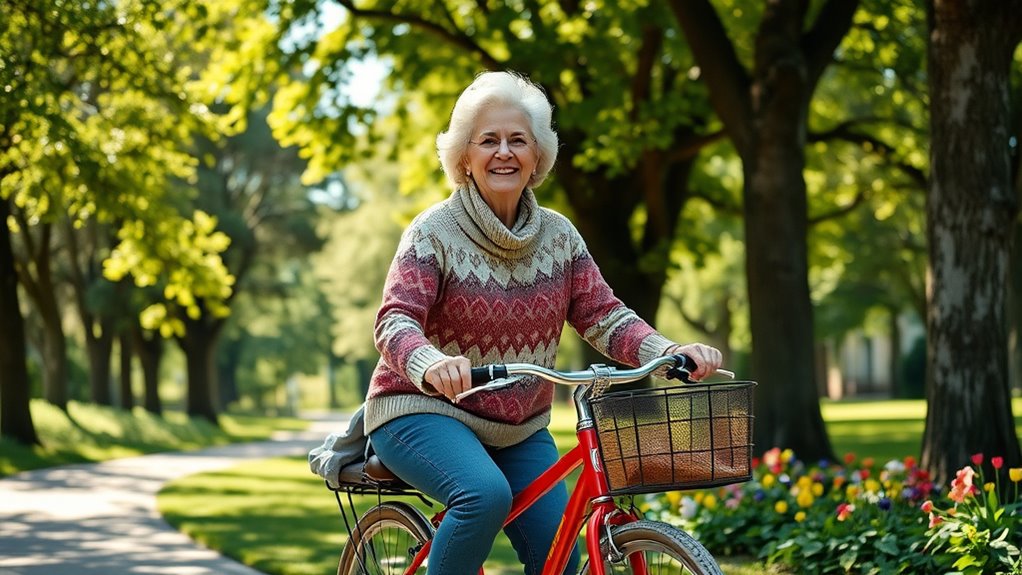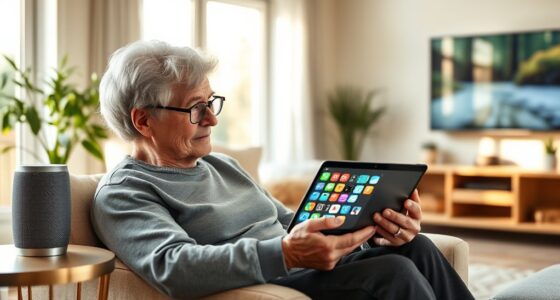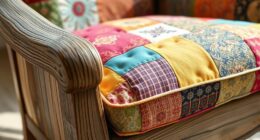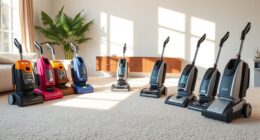To maintain your independence as you age, focus on proactive planning, home safety, and using assistive technology. Set aside savings, create an emergency plan, and regularly review your health. Make safety modifications like installing grab bars and good lighting. Utilize smart devices and health monitors to support daily routines. Stay active mentally and physically, keep a strong support network, and prioritize regular checkups. If you stay committed, you’ll discover how to enjoy a secure, fulfilling lifestyle every day.
Key Takeaways
- Implement home safety modifications like grab bars and good lighting to prevent falls and support mobility.
- Use assistive technology such as smart home devices and wearable safety gadgets to enhance independence.
- Develop and regularly update an emergency and health plan, sharing it with trusted contacts for quick response.
- Maintain regular health checkups and a healthy lifestyle to preserve physical and cognitive function.
- Engage in social activities and hobbies to boost mental well-being and reduce feelings of isolation.
Planning Financially for a Secure Future
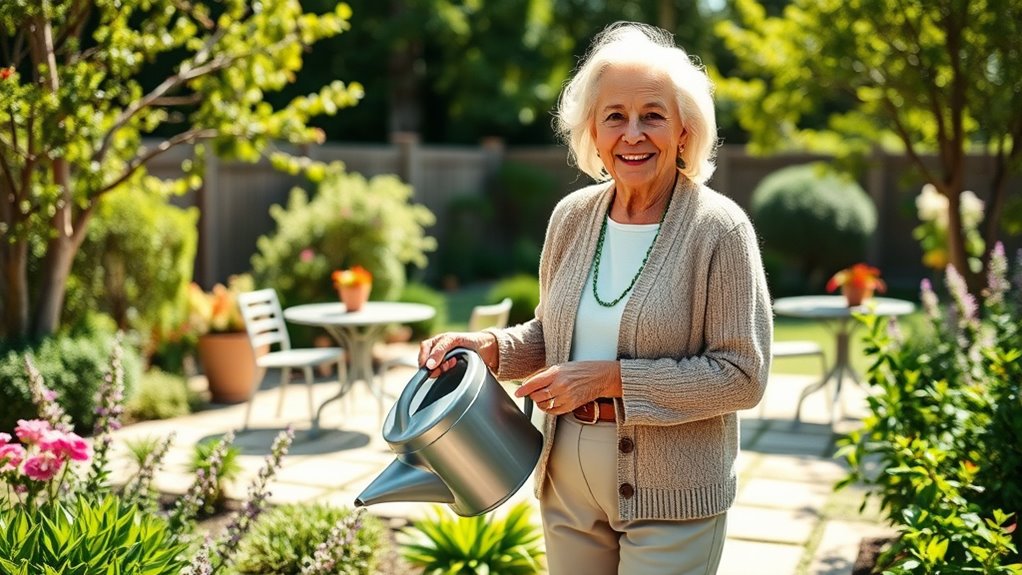
To maintain your independence as you age, it’s essential to plan your finances carefully. Good financial planning now can secure your future and support a comfortable retirement. Start early by establishing savings and investment strategies that grow over time. Regularly review and adjust your financial plan to meet changing needs and protect your assets. Be proactive about planning for expected expenses like housing, healthcare, and daily living costs, so you’re not caught off guard. Seeking professional financial advice can help you optimize your retirement funds and reduce vulnerabilities. Building an emergency fund provides a safety net for unexpected costs, ensuring your independence remains intact. Incorporating long-term health strategies into your financial planning can further support your independence as you age.
Ensuring a Safe and Accessible Home Environment
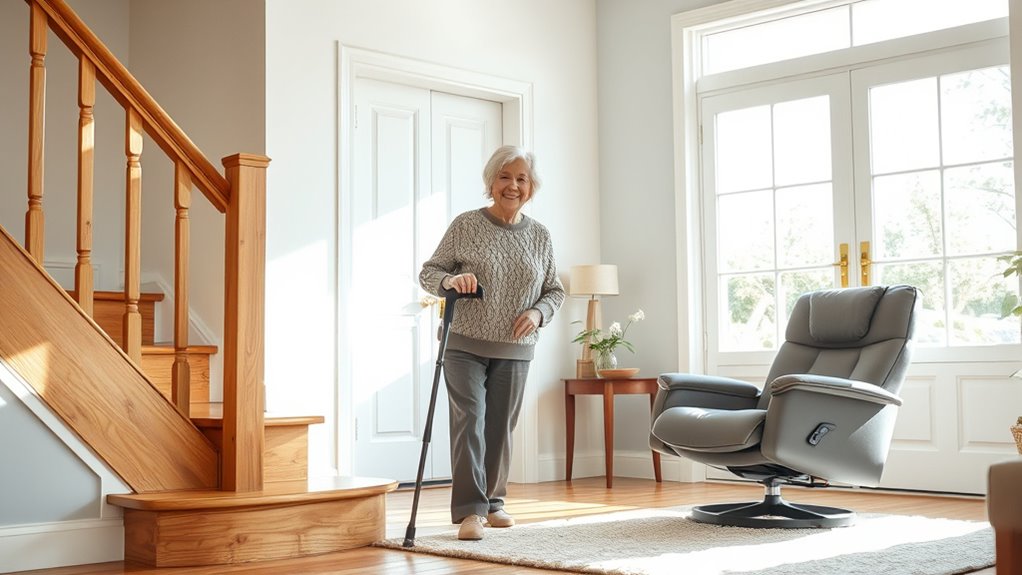
You can reduce fall risks by removing clutter, securing loose rugs, and fixing uneven floors. Installing handrails on stairs and grab bars in the bathroom offers essential support. Good lighting, especially at night, helps prevent trips. Regularly checking your home for hazards guarantees it stays safe and accessible as you age. Exploring home safety tips can further help you maintain independence as you grow older. Incorporating unique and wicked planters into your living space can also promote mindfulness and awareness, helping you stay alert to potential hazards in your environment.
Remove Trip Hazards
Ensuring a safe and accessible home environment starts with removing trip hazards that can lead to falls. You should secure rugs and loose carpets with non-slip backing to prevent slips, especially in home care settings. Repair uneven floorboards and cracked tiles to create smooth walking surfaces, reducing fall risks. Organizing electrical cords along walls and out of walkways to prevent tripping. Clearing clutter from hallways, stairs, and walkways guarantees clear paths for safe mobility. Additionally, regularly inspecting and maintaining floor surfaces can help identify and address potential hazards before accidents occur. Incorporating safety modifications such as grab bars and better lighting can further enhance home safety for aging individuals. Using appropriate maintenance routines can also prolong the lifespan of flooring and prevent unexpected hazards. Monitoring lighting conditions and ensuring adequate illumination can significantly reduce the risk of trips and falls. Regularly testing and inspecting safety features, like smoke detectors and electrical devices, is also vital for a comprehensive safety approach.
Enhance Lighting and Support
Adding proper lighting throughout your home considerably enhances safety and supports independence. Good lighting improves visibility in dark areas like hallways and bathrooms, reducing fall risks. Installing nightlights ensures safe navigation during nighttime. Proper lighting can also help you identify potential hazards early, preventing accidents before they happen. Make sure all stairways have sturdy handrails and are well-lit to prevent accidents. Securing loose rugs and floorboards minimizes tripping hazards, creating a safer environment. Maintaining well-lit entryways and outdoor pathways boosts confidence in mobility, encouraging independence outside your home. Regularly check and replace burnt-out bulbs to keep illumination consistent. Additionally, nail shapes can be used as a creative way to personalize your home decor, making spaces feel more inviting and comfortable. Incorporating lighting controls such as dimmers and motion sensors can further enhance safety and convenience. Proper lighting not only makes your home safer but also empowers you to move freely and confidently, preserving your independence as you age. Well-lit spaces are key to an accessible, safe, and supportive living environment. Enhanced on-device AI can also assist in monitoring lighting systems and alerting you to maintenance needs, further supporting safety. Moreover, advancements in automation technology are making it easier to manage lighting and other home systems effortlessly.
Leveraging Assistive Devices and Modern Technology
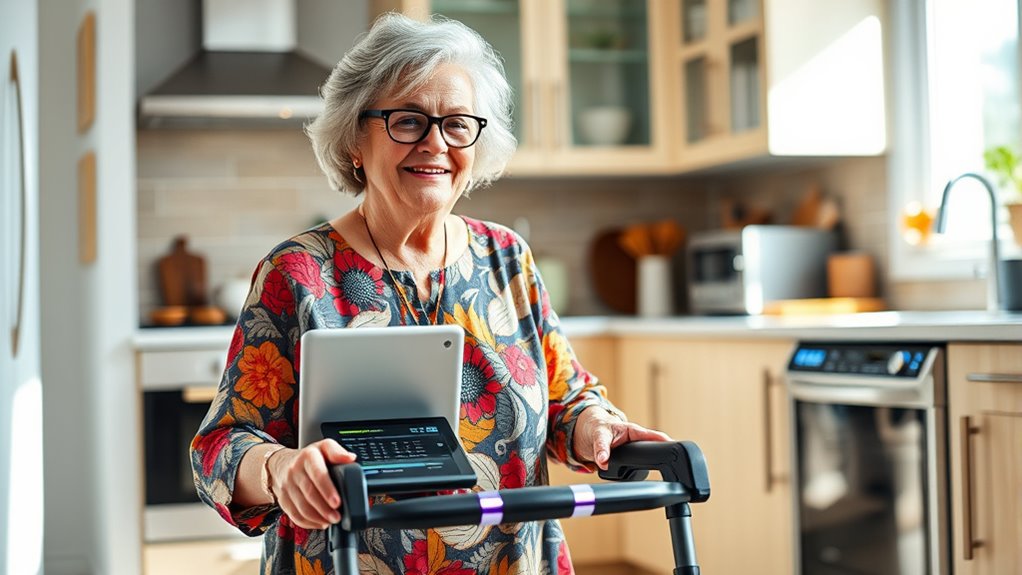
Using smart home automation, wearable safety devices, and user-friendly technology can greatly enhance your independence. These tools make it easier to communicate, manage your environment, and stay safe without constant help. A culinary experience approach to using these devices can help you discover new features that better suit your lifestyle. Regularly exploring and customizing these devices guarantees they meet your needs and keep you confident at home. Incorporating essential oils into your routine can also promote relaxation and well-being, further supporting your independence. Additionally, understanding the alternative terms for beekeepers can inspire you to explore hobbies like beekeeping, which can be both therapeutic and empowering as you age. Incorporating stylish wall organization systems can help you maintain a clutter-free space that is both functional and aesthetically pleasing. Selecting the right best outdoor ceiling fans can improve comfort and air circulation in outdoor spaces, contributing to a more enjoyable environment.
Smart Home Automation
Smart home automation systems empower older adults to manage their environment with ease, boosting both safety and independence. With these systems, you can control lighting, locks, and appliances remotely, reducing effort and risk. Voice-activated assistants and large-button interfaces make communication and device management simple, especially if you have mobility or visual challenges. Automated features like motion-activated lighting and automatic door locks prevent accidents and give you peace of mind. Integration of smart technology supports aging in place by providing real-time health data and environmental control, helping you stay autonomous. Here’s a quick look at common smart home features:
| Feature | Benefit |
|---|---|
| Remote control of devices | Increased independence and safety |
| Voice-activated commands | Easy communication, even with mobility issues |
| Automated safety features | Prevents accidents effortlessly |
| Health monitoring sensors | Promotes well-being and peace of mind |
Advances in data analysis by AI can also customize your smart home system to better suit your personal needs and routines.
Wearable Safety Devices
Wearable safety devices play a vital role in helping older adults maintain their independence by providing immediate assistance during emergencies. These devices, like call-for-help gadgets and fall detectors, let you summon help quickly, boosting safety at home and in the community. Incorporating personalized work environments can further enhance motivation and comfort while using these devices. Modern wearable technology often includes GPS tracking, so caregivers can monitor your location and respond promptly if needed. Studies show that wearable safety devices reduce fall-related injuries and give both you and your family peace of mind, supporting continued independent living. Understanding the different types of divorce process can help in planning for future contingencies and ensuring legal protections are in place. Features like large buttons, clear displays, and long battery life ensure reliable use and acceptance. When integrated with smart home systems, these devices can remotely control lighting, locks, and emergency alerts, further enhancing your ability to live independently with confidence. Additionally, advancements in assistive technology are making these devices more intuitive and user-friendly for older adults.
User-Friendly Technology
Building on the safety benefits of wearable devices, user-friendly technology plays a key role in helping you manage daily activities independently. User-friendly devices with large buttons, clear displays, and simple interfaces make technology accessible and easy to use. Natural Language Processing enhances communication by providing personalized responses, making interactions with devices more intuitive. Assistive technology tailored to your needs supports essential tasks like health monitoring, communication, and home management. Internet-connected devices enable you to stay connected with loved ones and access support services effortlessly. Smart home systems allow you to control lighting, locks, and appliances remotely, giving you greater independence. These modern tools promote safety and convenience, empowering you to maintain your autonomy while aging.
Prioritizing Regular Medical and Health Checkups
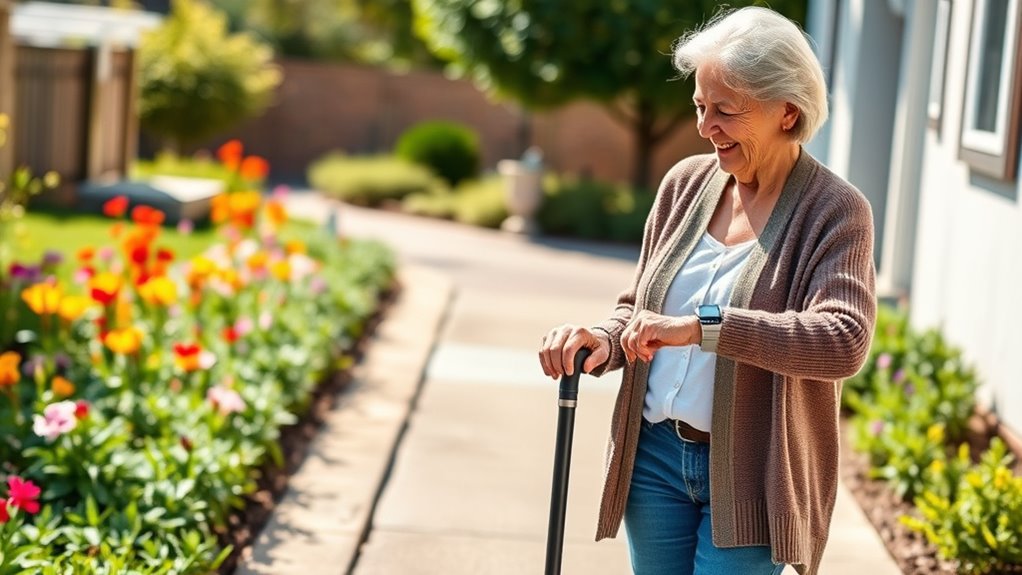
Prioritizing regular medical and health checkups is essential for maintaining your independence as you age. Regular health checkups allow early detection and management of health issues, helping you stay active and engaged. Routine visits to your primary care physician or specialists ensure continuous health monitoring and personalized care plans. These assessments prevent complications that could lead to functional decline or hospitalization, keeping you in control of your health. Keeping accurate records and medication lists during checkups supports safe treatment adjustments. Regular reviews empower you to make informed decisions, boosting confidence and autonomy.
| Benefits of Checkups | Impact on Independence |
|---|---|
| Early detection | Prevents functional decline |
| Personalized care | Maintains active lifestyle |
| Informed decisions | Enhances confidence |
Supporting Mental and Emotional Well-Being
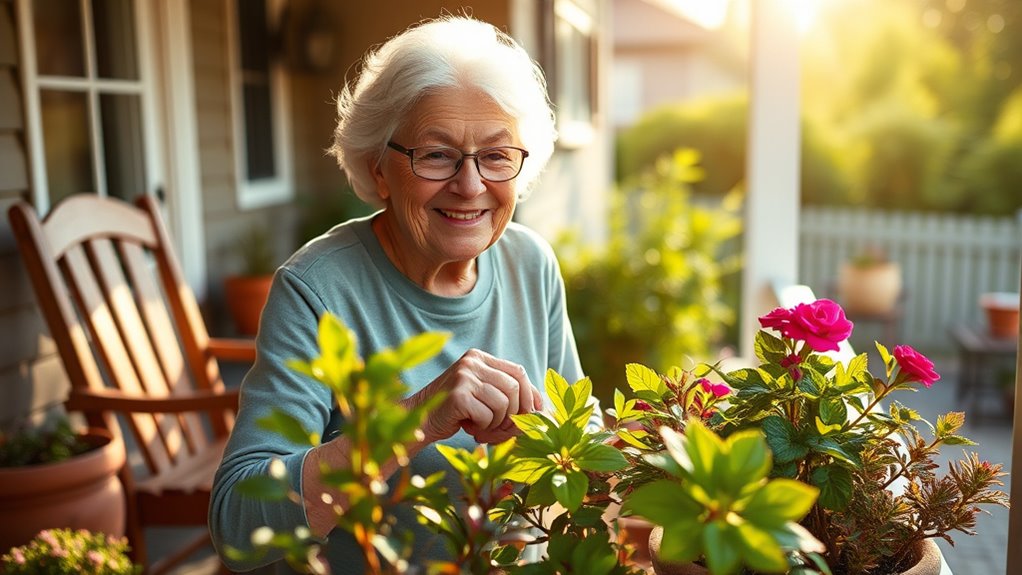
Maintaining mental and emotional well-being is essential for preserving your independence as you age. Prioritizing your mental health involves managing stress and engaging in self-care activities that nurture your emotional resilience.
Participating in social activities, hobbies, and community groups helps reduce loneliness, which can otherwise increase health risks.
Recognizing early signs of mental health issues and seeking therapy or counseling can support your emotional well-being and help you stay confident in handling challenges.
Building a strong support network ensures you feel valued and understood, strengthening your ability to manage emotional ups and downs.
Staying mentally active through reading, puzzles, or learning new skills also boosts cognitive health, enabling you to maintain independence longer and enjoy a fuller, more connected life.
Staying Mentally Active and Engaged
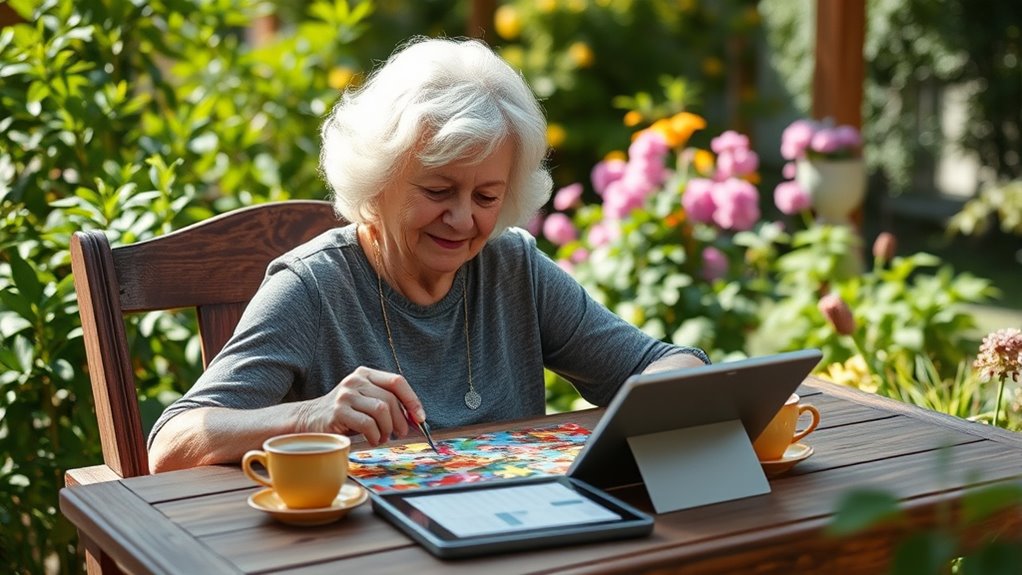
Staying mentally active and engaged is essential for preserving your independence as you age. Keeping your mind sharp through mental engagement helps delay cognitive decline and boosts your overall well-being.
To stay active mentally, try incorporating diverse activities into your routine:
- Solving puzzles or playing brain games
- Reading books or articles on new topics
- Participating in group discussions or clubs
- Learning a new skill or musical instrument
- Engaging in regular social interactions, whether in person or virtually
These activities not only stimulate your brain but also foster social connections and purpose. Staying active mentally supports neuroplasticity, helping you maintain cognitive function longer and enjoy a higher quality of life as you age.
Maintaining a Nutritious Diet and Healthy Lifestyle
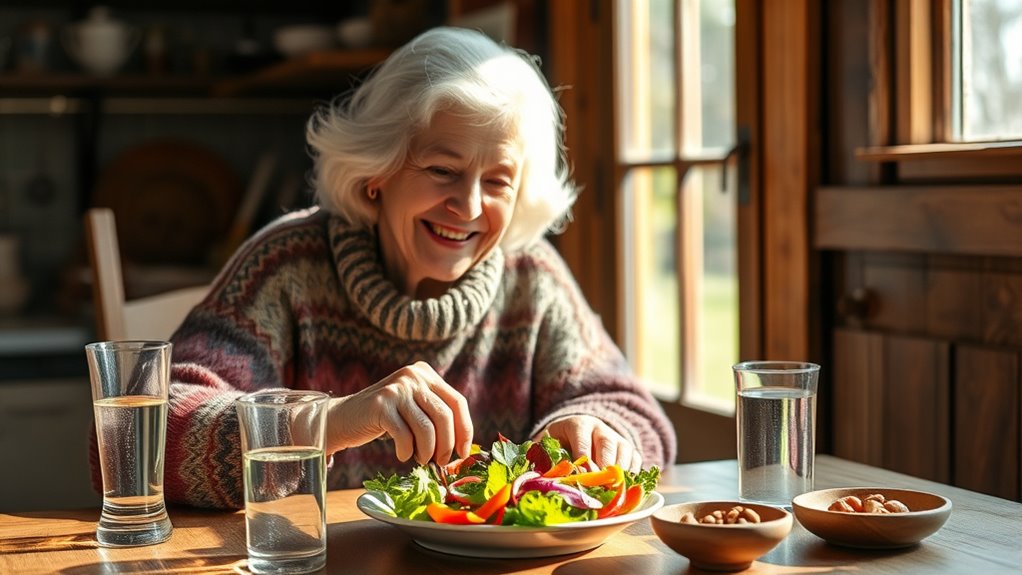
Adopting a nutritious diet and a healthy lifestyle is essential for supporting your overall well-being as you age. Good nutrition involves eating plenty of fruits, vegetables, whole grains, and lean proteins, which help prevent age-related illnesses.
Combining proper nutrition with regular physical activity boosts your strength, mobility, and mental health. Adequate nutrients are crucial for maintaining muscle mass, bone density, and immune function, reducing frailty risks.
Avoid processed foods and excess sugar to support cardiovascular health and manage chronic conditions like diabetes.
Staying hydrated is also vital; aim to drink enough fluids daily to keep your body functioning properly.
Cultivating a Strong Support Network
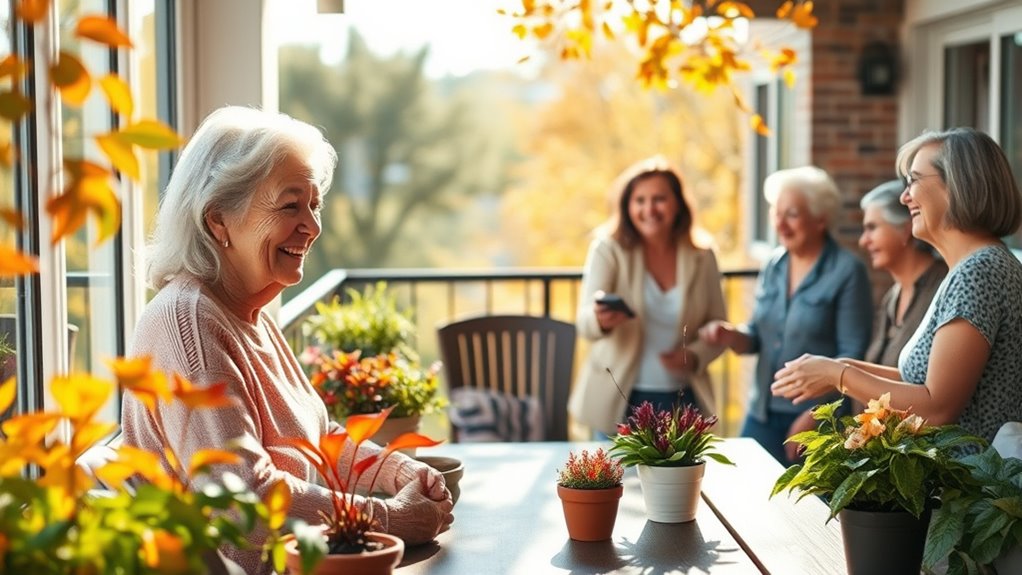
Building a strong support network is essential for preserving your independence as you age. Having solid social connections helps reduce loneliness, which can increase the risk of premature death by 14%. Engaging with family, friends, and community groups provides emotional support and reinforces your sense of autonomy.
Building strong social connections helps preserve independence and reduces loneliness as you age.
Technology like video calls and social media keeps you connected, even when in-person visits are limited. Recognizing signs of social isolation and proactively involving yourself in conversations or community events can help maintain your mental and physical health.
A strong support network not only offers practical assistance but also promotes a sense of purpose and well-being. Strengthening your social ties is a key step toward aging independently and confidently.
- Stay in touch with loved ones regularly
- Join local clubs or community groups
- Use technology to connect virtually
- Volunteer or participate in community activities
- Recognize and address social isolation early
Preparing an Emergency Plan and Staying Ready
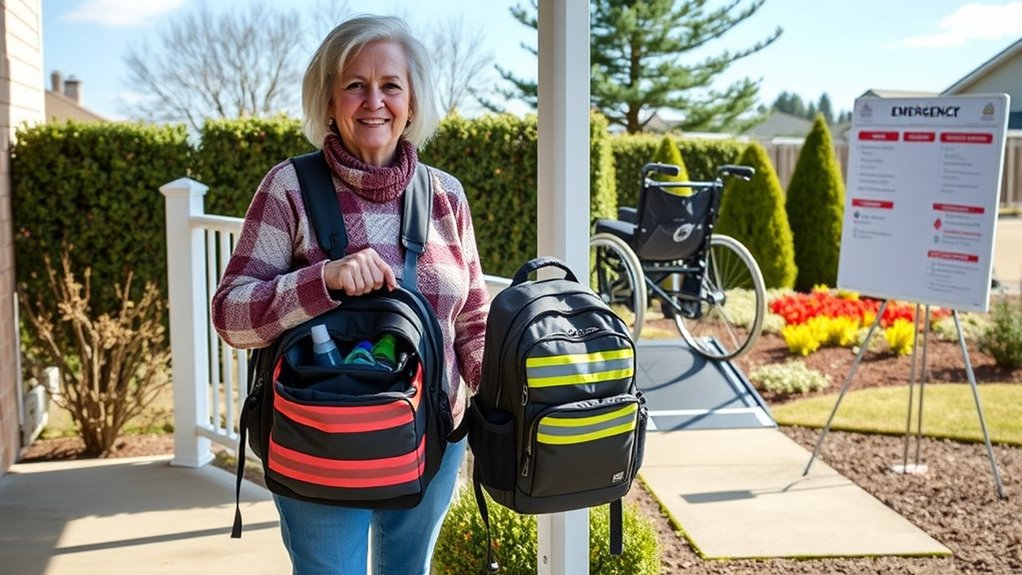
Having a strong support network makes it easier to handle emergencies, but being prepared yourself is equally important. Creating an emergency plan tailored to your needs is essential for aging with independence.
Write down key contact information, medical details, and specific action steps for different scenarios. Regularly review and update this plan to reflect any changes in your health or contacts.
Share your emergency plan with trusted family, friends, or caregivers to ensure everyone knows how to respond. Keep medications, medical supplies, and emergency kits organized in accessible locations for quick use.
Practicing emergency procedures and discussing potential situations help you feel confident and ready to act if a crisis occurs. Staying prepared keeps you independent and safe as you age.
Frequently Asked Questions
How to Maintain Independence in Old Age?
You want to stay independent as you age. Start by customizing your home with safety features like grab bars and secure rugs, making daily activities easier and safer.
Stay socially active, engage in meaningful hobbies, and use helpful technology to boost your confidence.
Remember, making your own decisions about health and routines keeps you in control.
What 3 Factors Affect an Elderly Person’s Independence?
You might wonder what impacts an elderly person’s independence. Physical health issues and mobility limitations can make daily tasks harder.
Environmental factors, like a safe and accessible home, are essential.
Additionally, social support from family and friends boosts confidence and helps maintain autonomy.
These three factors—health, environment, and social connections—directly influence how independently someone can live, shaping their quality of life as they age.
How Does Aging Affect Independence?
Aging affects your independence by bringing physical and mental changes that can make daily tasks more challenging. You might experience mobility issues, sensory impairments, or cognitive shifts that require adjustments or assistance.
However, you can still maintain a sense of independence by finding ways to adapt, using support systems, and staying engaged in meaningful activities. These efforts help preserve your autonomy and overall well-being despite age-related changes.
What Does Independence Mean for the Elderly?
You see independence as more than just doing daily tasks; it’s about staying engaged in hobbies, socializing, and feeling purposeful.
For you, independence means maintaining control over your life and enjoying meaningful activities that bring fulfillment. It’s not only about physical abilities but also about how you personally perceive your ability to live authentically and stay connected with what matters most.
Your sense of independence is deeply tied to your values and passions.
Conclusion
By taking these steps, you’ll turn aging into an epic adventure rather than a downhill slide. Imagine yourself standing tall and confident, wielding your financial armor, surrounded by a fortress of safety, and equipped with the latest tech gadgets. Your mind sharp as a blade, your body nourished and energized, all while your support network shields you like an unbreakable force. Aging becomes your greatest triumph—your legendary journey of independence.
